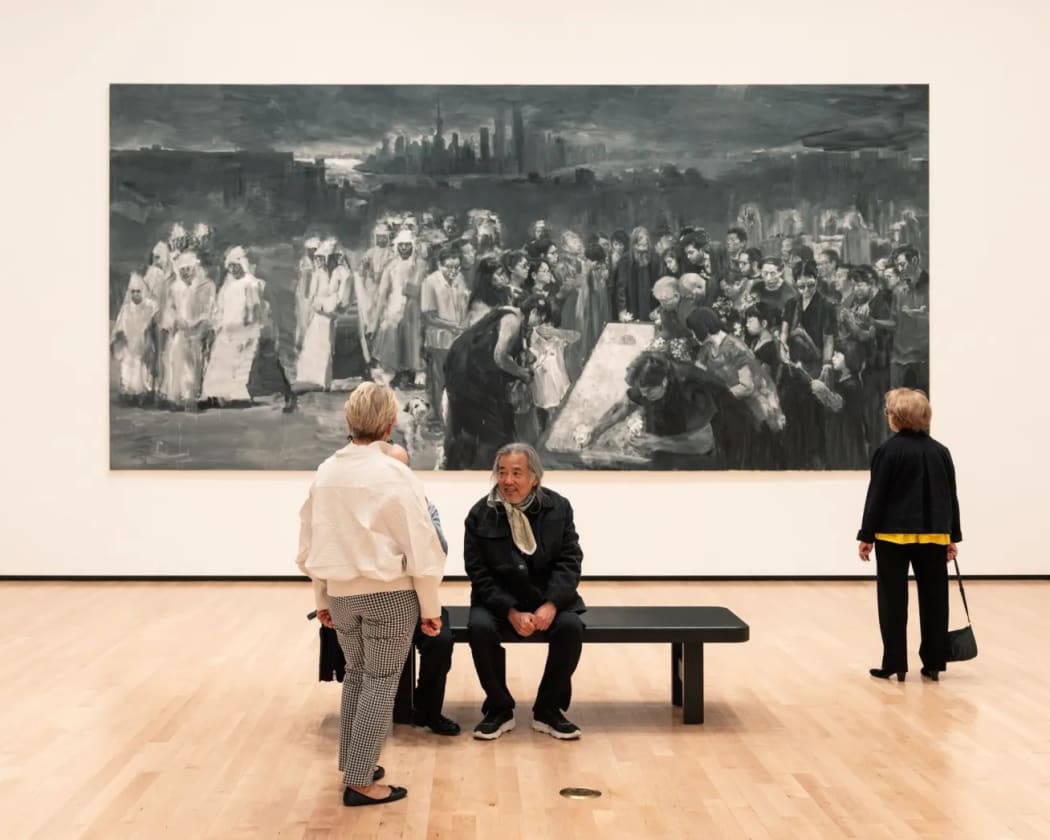
A born painter Yan Pei-Ming has cultivated a reputation for going big. His mammoth paintings — most of them portraits — appear gigantic even in the largest of spaces. He’s perhaps best known for his large-scale portraits of Mao Zedong, Barack Obama and Bruce Lee. The Mao portrait, an oil on canvas completed in 2005, is 8 feet tall.
For his exhibition at the Museum of Contemporary Art San Diego, the artist follows the same threadline. His larger-than-life project “A Burial in Shanghai” is on view at the La Jolla museum through Jan. 4. Kathryn Kanjo, the museum’s David C. Copley Director and CEO, shares her thoughts on the artist and his project, which made its debut in Paris in 2019 and is making its American premiere in La Jolla.
Q: This is the first time this work is being presented in the United States. How did this work come to be a part of MCASD’s spring schedule?
A: Yan Pei-Ming was the first living artist to be invited to exhibit at the Musée D’Orsay, France’s revered museum of 19th-century art. The artist’s project, “A Burial in Shanghai,” was developed as a response to the Realist painter Gustave Courbet (1819-77), yet the subject and sentiment is timeless and embodies the artist’s key qualities in a single, monumental project.
Deeply humanistic, Yan Pei-Ming often takes on immortality as his subject matter. He combines references to cultural histories alongside those of the present day, and he is celebrated for his compelling portraits. “A Burial in Shanghai,” effectively a triptych, is comprised of three towering paintings: an abstracted landscape, a monumental portrait and an imagined history painting.
Three years ago, while traveling to France with a group of MCASD supporters, we were fortunate to meet the artist and experience the canvas with him directly. His work addresses art history and the human condition. It is also deeply personal: This project is a heartfelt tribute to the artist’s mother, who passed away as he was preparing for the exhibition. Her visage looms over the gallery space, and it is her funeral that is imagined in “The Farewell,” the burial scene.
Yan Pei-Ming echoes a burial scene by Courbet from 200 years earlier, replacing the historical figures with depictions of his family and friends, the entire group who attended his mother’s actual funeral. It became clear that this epic cycle of paintings, with its universal sentiment of love and loss, could translate to MCASD’s majestic gallery spaces and communicate with audiences in the United States.
Q: When it debuted in Paris in 2019, what kind of reception did it receive?
A: Although born in Shanghai, China, Yan Pei-Ming has lived in France for more than 40 years, since he was 19 years old. He has achieved acclaim across the globe for his compassionate and commanding paintings, and in his adopted homeland, he is widely recognized and revered.
During the run of the exhibition, I was told that he would often be found in the galleries greeting and conversing with visitors. Similarly, following the MCASD Members’ Preview, Yan Pei-Ming returned to the museum the next day and sat in the Strauss Galleries greeting visitors, including two lucky school groups.
In France, visitors were able to see the Gustave Courbet painting that inspired the project and realize how artists are always contemporary in their own time. Yan Pei-Ming’s homage to Courbet helped show the enduring issues that continue to be expressed in art.
Q: What do you, as the curator, hope the viewer sees or experiences while viewing this work?
A: Surveys tell us that museumgoers hope to connect to content in deep and personal ways — that they want to think about things anew. They also seek respite and escape. Art delivers on all of those fronts, and contemporary art offers a kind of time travel: It makes our present moment even more immediate while connecting us to our rich and complicated history.
Yan Pei-Ming’s work plays on this tension directly — he cites familiar formats and images while inserting his very personal, yet surprisingly universal, vision of family, fealty and mortality. My hope is that people will be moved to see their own lives more fully for having experienced the wonder of Yan Pei-Ming’s human expression.